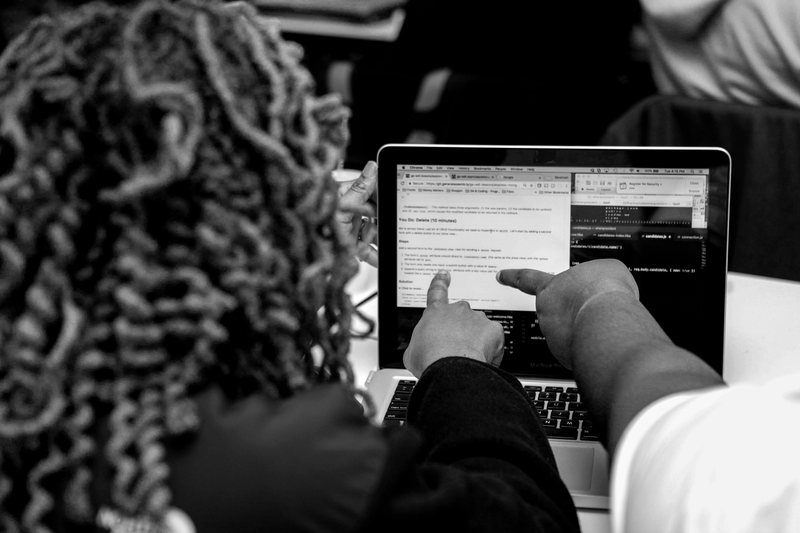Preparing to add that #OpentoWork label on LinkedIn? Perhaps you’ve been laid off or simply feel stuck and want to embark on something new.
Career transitions can be stressful, but they can also be overwhelmingly positive — offering a new beginning and a chance to evaluate, reset, and pivot to a more fulfilling career.
At GA, we’re all about helping you reimagine your career in design, coding, data analytics, user experience, and more. But no matter what your next career move might be, as you inventory your priorities and assess your options, don’t forget to take stock of another critical element — your transferable skills.
Regardless of career path, transferable skills are invaluable because you already have them. In this guide, we’ll walk you through what counts as a transferable skill, and how to uncover and articulate them to match the top skills employers look for today.
What Are Transferable Skills and Why Are They Important?
Transferable skills are soft skills that you can use in any situation or career. Think of strengths like communication, critical thinking, and creativity. If you enter a new environment with those, you have the tools to adapt and succeed, regardless of your technical acumen.
Transferable skills are important because technology changes so quickly that most job functions won’t look the same in five or 10 years — if not sooner. A person who has technical skills but lacks transferable skills like problem-solving and adaptability may struggle to propose new solutions and pick up new skills required for the future of work. While those with transferable skills will be well positioned to adapt and succeed, even if it means learning new tech skills.
Consider artificial intelligence. The rapid rise of AI and other technologies is making some tech skills obsolete, while simultaneously creating new tech skill categories. Rather than making transferable skills irrelevant, all this ebb and flow makes them even more potent. Our most valuable skills are those that are uniquely human — intrinsic qualities that can’t be replicated by bots.
What’s an Example of a Transferable Skill?
Here are examples of common transferable skills:
- Adaptability
- Analytical thinking
- Attention to detail
- Communication
- Creativity
- Critical thinking
- Digital literacy
- Empathy
- Initiative
- Leadership
- Mentoring
- Motivation
- Relationship-building
- Social influence
- Teamwork
- Time management
- Work ethic
Technical skills like Python, Excel, or social media competencies aren’t necessarily transferable, even though you can apply them in multiple jobs. Instead, consider broader competencies like problem-solving, analytics, or communication — skills that focus on the human element rather than the tool.
Transferable skills carry over between careers, from roles as different as supply chain coordinator to software developer. General Assembly alum Jaqueline Lemos Elizandro used her transferable skills, including problem-solving, creative thinking, and remote collaboration, to switch from the world of supply chains to a tech career in software development.
What Are the 3 Top Transferable Job Skills?
So, which transferable skills do employers look for in candidates today?
1. Creativity: Thinking Outside the Box
Albert Einstein once said, “Creativity is seeing what others see and thinking what no one else thought.” No matter the industry, you need creativity for innovation and problem-solving. Its importance is obvious for careers like design, but is equally essential for coding, business development, and leadership roles.
In 2023, the World Economic Forum Future of Jobs Report identified creative thinking as the fastest-growing skill and the second most in-demand skill overall. 56% of companies believe creativity is a core skill for workers, and 73% say it’s growing in importance.
Are you creative? Ask yourself these questions to find out: When did you last propose an unusual solution to a problem? How did you come up with the idea? Creativity is possible in any role and any industry.
2. Adaptability: Thriving in Change and Discomfort
Adaptability means the ability to adjust to new conditions. Experts have found that 37% of the top 20 skills needed in the job market have changed since 2016. That means the job you’re hired for today may look substantially different in five years — and you’ll need to adapt and reskill to keep up.
The World Economic Forum Future of Jobs Report named “resilience, flexibility, and agility” the third most-valued skill by employers. The findings are particularly true of tech companies and startups.
“Tech companies often experiment with new approaches and ideas in response to changes. The ability to navigate these turbulent waters quickly is crucial, as it reduces the risk of encountering obstacles,” shared Victoria Potapenko, General Recruiter at Jooble.
“When it comes to startups, adaptability is paramount. Startups often serve as the starting point for career switchers and juniors. Adaptability enables employees to swiftly adjust their work approaches without sacrificing efficiency.”
Are you adaptable? Ask yourself these questions to find out: How have you responded to substantial change in your industry or job? Have you reskilled or adjusted your workflows to meet the changing environment?
3. Digital Literacy: Evaluate, Create, Communicate
There are many names for digital literacy: computer literacy, technological literacy, or digital fluency. The American Library Association defines it as “the ability to use information and communication technologies to find, evaluate, create, and communicate information, requiring both cognitive and technical skills.”
If this sounds broad, it’s because it is. Digital literacy applies to many scenarios used across the workforce. Digital literacy means you can extract meaning from digital information and data. It means you can differentiate between reliable and unreliable sources, understand the interdependence between sources, and navigate social factors online.
Are you digitally literate? Ask yourself these questions to find out: When did you last source, synthesize, and share digital information? How did you communicate or visualize it using digital technology?
How Do You Identify Transferable Skills for a Career Change?
Research from TestGorilla found that more than half of workers can’t confidently identify their transferable skills and aren’t sure how to include them in a resume. To identify which transferable skills are your hidden superpowers, try one of these three activities:
- Read through the skills list above and highlight three to five skills that stand out to you.
- Write down three major accomplishments or projects from your most recent job. Identify which skills you used for each (e.g., communication, adaptability, or analytics).
- Connect with an expert to narrow down your transferable skills — an outside perspective can identify something you don’t see in yourself. General Assembly’s team has experts to connect with career switchers to conduct a personalized skills audit.
How Do You Highlight Transferable Skills in a Job Search?

While recruiters and hiring managers value transferable skills, they can struggle to identify them in the interview process. But with these three steps, you can make their job easier and put yourself at the top of their candidate list.
1. Add Transferable Skills to Your Resume
Adding your top transferable skills to the skills section of your resume will help you stand out in the early stages of candidate screening. You can also showcase them by weaving them into your summary statement. Here’s an example: Motivated, adaptive sales professional with a history of exceeding targets — an empathetic leader with a track record of fostering collaboration across teams.
2. Include Key Transferable Skills in Your Cover Letter
“A cover letter is an excellent opportunity to stand out from other candidates,” shared Potopanko. “In it, you can specify your motivation and which transferable skills will help the company achieve its goals.”
Carefully read the job description for the job you’re applying for and extract the transferable skills listed. Emphasize these skills in your cover letter alongside your relevant background information and technical skills.
3. Use the STAR or PARLA Method in Interviews
Once you reach the interview stage, think about how you’ll demonstrate your transferable skills in an interview setting. “In my role as a recruiter, Potapanko shared, “I often work with career switchers and positions that require little to no prior work experience because the company offers fundamental training. In such cases, transferable skills are crucial during the interview process.”
Recruiters often use the STAR or PARLA methods to evaluate competencies in interview candidates. These techniques ask interviewees to demonstrate a skill by sharing a story about how they’ve used that skill in action. These questions usually start with a prompt like, “Tell me about a time…”
Even though you don’t know the questions in advance, you can effectively prepare for interviews using the STAR method. Think back and write down at least three of your greatest accomplishments from your past job, school, or experience. Then, use the STAR framework to describe each accomplishment:
Situation
A specific situation in which you found yourself previously. This could be a problem, project, task, or any other condition that’s the basis for demonstrating a skill.
Task
The mission or goal set before you in that situation. What were the objectives and requirements for completing the task?
Action
The steps you took to address the task, including specific actions and reactions.
Result
The outcomes of your actions and the goals achieved in that situation. It’s important to provide specific numerical or qualitative results to demonstrate how effective your approach was.
If the transferable skill you want to showcase is adaptability, you might share a story about how you had to change a major project mid-stream or reschedule an event you were planning.
PARLA is a similar framework with the acronym standing for Problem, Action, Result, Learned, Application.
Problem
The specific problem you addressed to demonstrate a skill.
Action
The action you took to solve the problem and demonstrate a skill
Result
The result you achieved by the action you took and the problem you solved.
Learned
The learning outcomes of your actions and results in your problem-solving situation. Remember — specific, quantifiable and qualifiable data works best here.
Application
How you can apply your demonstrated transferable skill moving forward.
Practice telling your STAR or PARLA stories until you’re comfortable telling them from memory. You’ll be surprised just how adaptable they are to multiple interview questions.
Ready to make your next career move? You already have the transferable skills within you to land your dream job. You just need a little support and training.
Contact us for a personalized skills audit to find which tech career could be the right fit for you.
